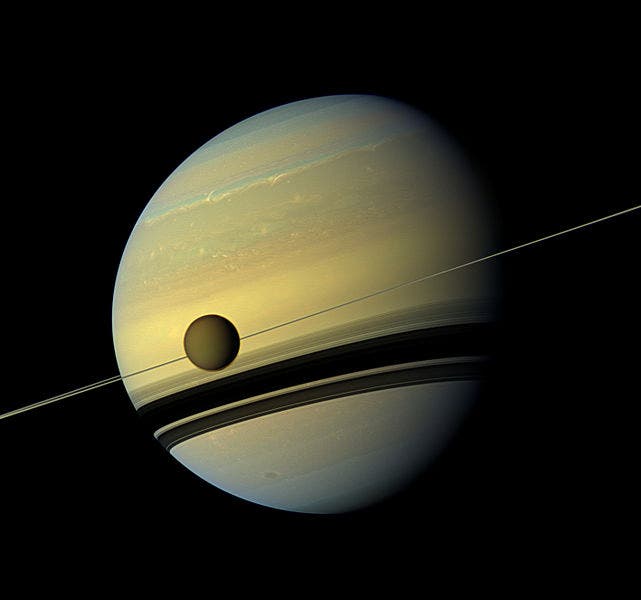Saturn’s moon Titan, an icy world shrouded by a hazy atmosphere, is the second-largest moon in our solar system, nearly 50% larger than the Earth’s moon.
In a new study published in Nature Astronomy, a team of researchers report that Titan may be straying from its planet at a much faster rate than anticipated.

Every moon slowly drifts away from its planet due to tidal forces. The orbiting moon exerts a gravitational pull on the planet as it orbits, creating a temporary bulge as it passes over — this is also the reason why we have high tides and low tides on Earth, for instance.
The planet’s spin sweeps the bulge forward ever so slightly, which in turn pulls on the moon and transfers it into a higher orbit. That way, the moon moves away from the planet ever so slightly each year.
So long, old friend
Previously, scientists had estimated the rate Titan moves away from Saturn to be around 0.1 cm per year. But according to recent data gathered by NASA’s Cassini spacecraft, Titan actually drifts away 100 times faster than expected, at a rate of approximately 11 centimeters each year.
These findings, while contradicting previous predictions, agree with a hypothesis proposed in 2016 by Jim Fuller, Jing Luan, and Eliot Quataert. The researchers proposed a mechanism also observed in binary stars called resonance locking, which could explain the fast migration seen in Saturn’s moon Titan. This is a process where the gravitational force of the moon squeezes the planet and forces it to oscillate. In this case, the orbital motion of Titan lines up with internal motions inside Saturn increasing the efficiency of the tidal forces and leading to a faster migration rate.
This finding also bears significant implications for the formation of Saturn’s rings and moon system (which hosts over 80 moons).
If the speed at which Titan is straying from Saturn is so large now, it implies that it was also larger in the past. This means that Titan, previously thought to have formed at a similar distance from its planet as where it is now, may have formed much closer to Saturn and then migrated outwards. This changes our understanding not only of how Saturn’s rings and moons formed but also interactions in binary star systems, galaxies, and exoplanets in close orbit to their stars.
Now, scientists await more data from the Juno space probe orbiting Jupiter which could validate the theory of resonance locking further.









